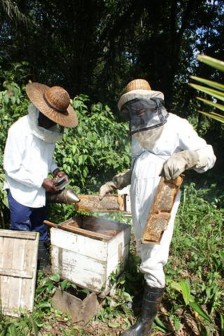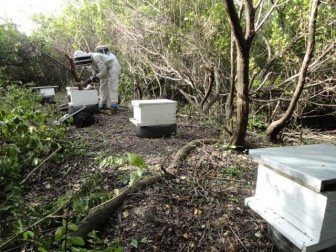Aubrey Roberts believes that a good case exists for the creation of a more amicable relationship between bees and humans. It is a view which most ordinary Guyanese probably do not share. Among the uninitiated, bees evoke a range of negative feelings ranging from apprehension to naked terror.
In recent years the loss of life resulting from bee attacks has done little to change the relationship for the better. Roberts sees things differently. Bees, he says, are the prime movers behind a potentially multi-million dollar industry which Guyana would do well to take far more seriously.

Roberts, who is the serving Vice President of the Caribbean Bee Keepers Association and a Director of Kingdom Apiary Products and Supplies specializes in neutralizing the controversial Africanized bees. Fear of bees, he says, is largely a function of ignorance. The grizzly tales of humans and animals being stung to death by violent swarms of bees invariably do not explain the behavioir of bees. He insists that, on the whole, bees mind their own business, becoming aggressive only when they are threatened.
“Bees will only become aggressive when they are disturbed,” Roberts says. He makes a distinction between swarming bees, simply moving around seeking out a place to hive and colonies of bees. The latter group he says, are usually preoccupied looking for a haven where a colony can be established. It is when their colonies – their permanent homes – are disturbed – that bees become aggressive. Colonies, Roberts says can be disturbed by noises and smells. In the latter circumstance, if, for example, you are cooking jam close to colony of bees they will try to get at the jam. If you try to prevent them they are likely to attack you.
Roberts, whose beekeeping enterprise comprises around 100 hives, says that bee alerts have become commonplace. Kingdom Apiaries gets at least “a couple of calls everyday” to attend to bee emergencies. During “swarming season” it’s worse. The calls increase to between 10 and 12 everyday. “Swarming season” is that period during which the bees are engaged in the process of collecting honey. Swarming is prevalent during the early months of the year – January and February particularly – and again in June. The recent spate of bee attacks would appear to coincide with the swarming season.
Bee-removal operations are undertaken at a cost to the person requesting the removal. Costs range from $6,000 for the removal of a swarm that might have just landed in an open area to $15,000 for colonies that might have made their homes in the roofs of houses. Roberts says that in cases where bees are found in public places and might pose an imminent danger, Kingdom Apiaries remove them free of cost.
“After we remove the bees we hive them in a nursery before they are moved to apiaries,” he added.

The boxes in which bees are collected cost around $11,000 each and Roberts says that greater official attention to the apiculture industry should include the creation of a fund to finance the removal of swarms.
Roberts believes the media have played a role in demonizing bees, a task which he concedes has been made easier with the fearsome reputation of the Africanized bees, which have found their way into Guyana – probably from Brazil – in recent years. Except of course that Roberts insists that its not the physical threat but the economic opportunity afforded by the presence of Africanized bees that we should be concerned about. Quite simply, they are the most prolific gatherers of honey.
It is the missed economic opportunity resulting from the uneasy relationship between humans and bees in Guyana that concerns Roberts. The physical conditions are ideal for the creation of a lucrative honey industry. Up until now, however, the opportunity has not been nearly as well-exploited as it can be.
Up to two years ago Guyana imported more than 4,000 gallons of honey mostly as a sweetener for locally manufactured beverages. While accurate statistics are difficult to come by it was estimated then that local production averaged 5,000 gallons from more than 1,500 hives across the country. Then, pure honey was sold on the world market at around US$160 a gallon.
Linden Stewart, an associate of Roberts, estimates that the country’s vast rainforests can probably support up to 17 million colonies of bees. The gap between potential and actualization is evident.
According to the 2011 International Honey Market Report for the American Honey Producers Association the big players in the global honey industry – countries like the United States, China, Argentina and Brazil reaped sizeable profits from the sector despite the fact that 2011 was by no means the best year for the sector. In the US, for example, an unusually high number of natural disasters last year pushed honey production down to approximately 150-160 million pounds, one of the lowest crops in recorded history of honey production. Still, the returns are considerable.
Argentina, the top honey exporter to the US in 2011, produced 165 million 176 million pounds last year. In 2009 Argentina was the top exporter to the world, earning around US$160 million from exports. Last year Mexico, the fourth largest exporter of honey in 2009, exported over 35 million pounds of honey. Brazil’s honey production has continued to expand, spurred in large part by Brazil’s ability to produce organic honey in its virgin areas. Last year, too, US honey imports showed dramatic changes with countries such as India, Indonesia significantly increasing their exports to the US.
Roberts believes Guyana is ideally positioned to take more advantage of the continually rising demand for high-quality honey and the production can meet local demand in addition to securing a share of the export market. Currently, only small quantities of honey produced here are exported to the region. Local supermarket shelves reflect the weakness of the local honey industry. Roberts says that there could be as many as six imported brands available in local supermarkets as against two or three local brands, including Natural Rainforest Honey, a product of Kingdom Apiaries. Honey is also retailed by travelling traders.
Driven by an increasing awareness of its health benefits the global honey market is projected to exceed 1.9 million tonnes by 2015. Several honey producers are also launching new products and varieties at regular intervals. With world raw honey supplies continuing to be limited at the beginning of 2012, prices in the United States had reached as high as US$250 and Roberts believes that current trends provide more than ample encouragement for expansion on the local industry.
While there may be hundreds of beekeepers in Guyana, Roberts said there is no “sound structure” in place to support an effective industry. Turning the industry around is one of his preoccupations.
On Easter Saturday local beekeepers will be hosting a Honey Fair in Georgetown. The objectives, he says, are to promote the range of products which the industry offers as well as to educate the public on the economic and environmental importance of bees. It’s a start which he believes can both help to alter the present relationship between humans and bees as well as pave the way for the growth of an industry which can contribute significantly to exploiting the potential of the vast number of bees which, so often, create apprehension and fear among the people who encounter them.




